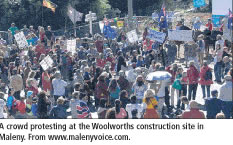Mullumbimby Action Group -> articles -> notsustainable
Woolworths is Not Sustainable, by David Maslow
Woolworths symbolizes everything that is wrong with global corporate economics and behaviour. This monster can be summed up in one word, exploitation. Woolworths exploits...
That’s right, Woolies is not sustainable. Then again, neither is Australia’s present economy and lifestyle. This is unarguable given the rate at which humanity is gobbling up Earth’s finite resources. Studies have shown that if much of the world consumed at the rate of America (read Australia), we will need the natural resources of up to five planets similar to our own (see www.storyofstuff.com). And India and China are making every effort to catch up.But let’s look at Woolies. Why? Simply put, Woolies symbolises everything that is wrong with global corporate economics and behaviour. This monster can be summed up in one word, exploitation. Woolworths exploits:
• Natural resources,
• Farming,
• Community,
• Bad eating habits.
Natural Resources
At the March 15th forum in Lismore, Feeding Our Future, Prof. Alan Roberts presented a chart showing how Woolworths consumes energy many times greater than local retailing for the same outcome. The extra energy consumption is contained mostly in storage, food miles, refrigeration and air conditioning.
Packaged, mass produced food products (food-like substances) rely on industrial, chemical-dependent agriculture. This is the most inefficient, in terms of land use and energy consumption, and toxic form of agricultural production. Compared to a non-industrial farm, Big Ag uses many times the acreage per unit of production, depletes the soil, causes erosion, and leaches toxins into the waterways and aquifers.
Farming
Farmers who have sold to Woolworths tell of demands for lowest possible pricing, that pricing to Woolies must be lower than to any other retailer, and that loyalty is non-existent in difficult times. If cheaper prices can be found elsewhere, including from overseas suppliers, Woolies will switch in a heartbeat. Woolworths may be selling 50% or more of fresh produce sold in Australia. This puts enormous downward pressure on farm income.
Woolworths has no concern for the use of chemical fertilisers and pesticides, plus other non-sustainable monoculture practices that may reduce prices in the short run. They currently sell imported genetically modified (GM) food, which suggests they are not opposed to the disastrous decisions by Victoria and NSW to allow GM crops in Australia, which is, by the way, supported by Tony Burke, Kevin Rudd’s new Minister for Agriculture, Fisheries and Forestry. GM crops threaten non-GM farmers through wind blown seeds and other accidents. Also, the claimed increase in productivity and pesticide use is bogus, as experience in Canada and India shows. It’s just more of the same for Big Ag, and non-sustainable.
Community
Money spent in Woolworths leaves the community immediately, except for local wages. It does not recirculate in the community as it mostly would if spent in locally owned stores (Keynes called this the Local Multiplier Effect). The effect is to deplete wealth within the community. More directly affected are local retailers put out of business by direct competition, or by changing the pattern of shopping away from the town centre to one-stop-shopping’s distant parking lots.
When a Woolworth’s opens up outside the centre of a small town, it changes the flow of shopping traffic (foot and vehicular). Typically, road traffic systems are reworked to accommodate the new traffic pattern, usually at public expense. The essence of a good retail location is exposure to traffic, so the town centre declines as a shopping location. But what also declines is the community life around the local shops, cafes, pubs and sitting areas of the town centre. The new incidental meeting place is the aisles of the supermarket. To top it off, Woolies introduces the noise, traffic hazards and air pollution of the huge refrigerated supply trucks.
Bad Eating Habits
Supermarket shelves are replete with processed foods, enticingly packaged, and ubiquitously advertised. These “food-like substances” are typically sweetened, artificially coloured and laced with preservatives. They are sourced from chemically driven agriculture, including hormone and antibiotic fed livestock. Such foods are a direct cause of the almost epidemic incidence of diabetes among poorer populations, plus heart disease and other chronic maladies through compromised immune systems. The medical and hospitalisation costs borne by society are further hidden costs of cheap and fast junk “food”. Woolworths thrives on it.
The business model exemplified by Woolworths is “successful”, but not because it is a superior “free market” system. It works because it is subsidised all along the way by taxpayers, farmers and those (all of us?) left to suffer from and clean up the mess. Business leaves the true cost of the negatives of production, distribution, waste and pollution off the balance books, calling them externalities. Taxpayers are left subsidising energy producers, road construction and maintenance, health care, and mitigating climate change. So much for cheap prices.
The Woolies model is virtually a closed system, offering little or no resilience to the coming adjustments needed to engage global warming, oil depletion and water scarcity. At every level this system is not sustainable.
article courtesy of The Byron Shire Echo 2008 and David Maslow
| April 2025 | ||||||
|---|---|---|---|---|---|---|
| S | M | T | W | T | F | S |
| 1 | 2 | 3 | 4 | 5 | ||
| 6 | 7 | 8 | 9 | 10 | 11 | 12 |
| 13 | 14 | 15 | 16 | 17 | 18 | 19 |
| 20 | 21 | 22 | 23 | 24 | 25 | 26 |
| 27 | 28 | 29 | 30 | |||
No events for today
Add your event here


